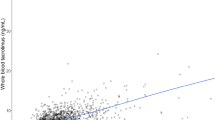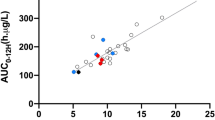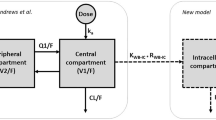Abstract
Objectives
The objectives of this study were to develop population pharmacokinetic models of tacrolimus in an Asian population with whole blood and plasma drug concentration data, to compare the variability of the pharmacokinetic parameters in these two matrices and to search for the main patient characteristics that explain the variability in pharmacokinetic parameters.
Study design
Prospective pharmacokinetic assessment followed by model fitting.
Patients
Whole blood samples from 31 liver transplant patients in a local hospital receiving oral tacrolimus as part of their immunosuppressive therapy were assessed. Plasma samples from 29 of the 31 patients were also evaluated. Concentrations of tacrolimus in whole blood and plasma were determined by an electrospray high-performance liquid chromatography with tandem mass spectrometry. Two hundred and thirteen whole blood and 157 plasma tacrolimus concentrations were used for building two nonlinear mixed-effects population models to describe the disposition of tacrolimus in whole blood and plasma, respectively. Covariates that were investigated included demographic characteristics, biological markers of liver and renal functions, corticosteroid dose and haematological parameter.
Results
A one-compartment model was used to describe the whole blood and plasma concentration-time data of tacrolimus after oral administration. For the whole blood population model, the population estimates of the first-order absorption rate constant (ka), apparent clearance based on whole blood concentration after oral administration (CLB/F) and apparent volume of distribution based on whole blood concentrations after oral administration (Vd,B/F) were 2.08h−1, 14.1L/h and 217L, respectively. The coefficient of variations (CVs) of interpatient variabilities in CLB/F and Vd,B/F were 65.7% and 63.8%, respectively. Bodyweight, liver and renal function influenced CLB/F, while height and haematocrit influenced Vd,B/F. The residual (unexplained) variability was 34.8%. For the plasma population model, the population estimates of the ka, apparent clearance based on plasma concentrations after oral administration (CLp/F) and apparent volume of distribution based on plasma concentrations after oral administration (Vd,p/F) were 5.21h−11, 537 L/h and 563L, respectively. The CVs of interpatient variabilities in CLp/F and Vd,p/F were 96.0% and 105.4%, respectively. Bodyweight was found to influence CLp/F, while the erythrocyte-to-plasma concentration ratio influenced Vd,p/F. The residual (unexplained) variability was 49.8% at the mean plasma concentration of 1.1 ng/mL.
Conclusions
Whole blood and plasma population pharmacokinetic models of tacrolimus in Asian adult and paediatric liver transplant patients were developed using prospective data in a clinical setting. This has identified and quantified sources of interindividual variability in CLB/F, Vd,B/F, CLp/F and Vd,p/F of tacrolimus in Asian liver transplant patients. Information derived from the whole blood population model may subsequently be used by clinicians for dosage individualisation through Bayesian forecasting.












Similar content being viewed by others
References
Venkataramanan R, Swaminathan A, Prasad T, et al. Clinical pharmacokinetics of tacrolimus. Clin Pharmacokinet 1995; 29: 404–30
Jusko WJ, Thomson AW, Fung J, et al. Consensus document: therapeutic monitoring of tacrolimus (FK-506). Ther Drug Monit 1995; 17: 606–14
Sawada S, Suzuki G, Kawase Y, et al. Novel immunosuppressive agent, FK506: in vitro effects on cloned T cell activation. J Immunol 1987; 139: 1797–803
Sam WJ, Aw M, Quak SH, et al. Population pharmacokinetics of tacrolimus in Asian paediatric liver transplant patients. Br J Clin Pharmacol 2000; 50: 531–41
Lensmeyer GL, Poquette MA. Therapeutic monitoring of tacrolimus concentrations in blood: semi-automated extraction and liquid chromatography-electrospray ionization mass spectrometry. Ther Drug Monit 2001; 23: 239–49
Ette EI, Ludden TM. Population pharmacokinetic modeling: the importance of informative graphics. Pharm Res 1995; 12: 1845–55
Jonsson EN, Karlsson MO. Xpose: an S-PLUS based population pharmacokinetic/pharmacodynamic model building aid for NONMEM. Comput Methods Programs Biomed 1999; 58: 51–64
Breiman L, Friedman JH, Olshen RA, et al. Classification and regression trees. Belmont (CA): Wadsworth International Group, 1984
Jusko WJ, Piekoszewski W, Klintmalm GB, et al. Pharmacokinetics of tacrolimus in liver transplant patients. Clin Pharmacol Ther 1995; 57: 281–90
Wallemacq PE, Furian V, Moller A, et al. Pharmacokinetics of tacrolimus (FK506) in paediatric liver transplant recipients. Eur J Clin Pharmacol 1998; 23: 367–70
Sanchez MJG, Manzanares C, Santos-Buelga D, et al. Covariate effects on the apparent clearance of tacrolimus in paediatric liver transplant patients undergoing conversion therapy. Clin Pharmacokinet 2001; 40: 63–71
Mancinelli LM, Frassetto LM, Floren LC, et al. The pharmacokinetics and metabolic disposition of tacrolimus: a comparison across ethnic groups. Clin Pharmacol Ther 2001; 69: 24–31
Jain AB, Venkataramanan R, Cadoff E, et al. Effect of hepatic dysfunction and T tube clamping on FK 506 pharmacokinetics and trough concentrations. Transplant Proc 1990; 22: 57–9
Jain AB, Abuelmagd K, Abdallah H, et al. Pharmacokinetics of FK506 in liver-transplant recipients after continuous intravenous-infusion. J Clin Pharmacol 1993; 33: 606–11
Venkataramanan R, Jain A, Warty VS, et al. Pharmacokinetics of FK-506 in transplant patients. Transplant Proc 1991; 23(6): 2736–40
Gruber SA, Hewitt JM, Sorenson AL. Pharmacokinetics of FK506 after intravenous and oral administration in patients awaiting renal transplantation. J Clin Pharmacol 1994; 34: 859–64
Staatz CE, Willis C, Taylor PJ, et al. Toward better outcomes with tacrolimus therapy: population pharmacokinetics and individualized dosage prediction in adult liver transplantation. Liver Transplant 2003; 9: 130–7
Jacobson P, Ng J, Ratanatharathorn V, et al. Factors affecting the pharmacokinetics of tacrolimus (FK506) in hematopoietic cell transplant (HCT) patients. Bone Marrow Transplant 2001; 28: 753–8
Fukatsu S, Yano I, Igarashi T, et al. Population pharmacokinetics of tacrolimus in adult recipients receiving living-donor liver transplantation. Eur J Clin Pharmacol 2001; 57: 479–84
Okabe H, Hashimoto Y, Inui K. Pharmacokinetics and bioavailability of tacrolimus in rats with experimental renal dysfunction. J Pharm Pharmacol 2000; 52: 1467–72
Okabe H, Yano I, Hashimoto Y, et al. Evaluation of increased bioavailability of tacrolimus in rats with experimental renal dysfunction. J Pharm Pharmacol 2002; 54: 65–70
Gibson TP. Influence of renal disease on pharmacokinetics. In: Evans WE, Schentag JJ, Jusko WJ, editors. Applied pharmacokinetics: principles of therapeutic drug monitoring. 2nd ed. Vancouver (WA): Applied Therapeutics, 1986: 83–115
Piekoszewski W, Chow FS, Jusko WJ. Disposition of tacrolimus (FK506) in rabbits: role of red cell binding in hepatic clearance. Drug Metab Dispos 1993; 21: 690–8
Legg B, Roland M. Saturable binding of cyclosporin A to erythrocytes: estimation of binding parameters in renal transplant patients and implications for bioavailability assessment. Pharm Res 1988; 5(2): 80–5
Nagase K, Iwasaki K, Nozaki K, et al. Distribution and protein binding of FK506, a potent immunosuppressive macrolide lactone, in human blood and its uptake by erythrocytes. J Pharm Pharmacol 1994; 46: 113–7
Yasuhara M, Hashida T, Toraguchi M, et al. Pharmacokinetics and pharmacodynamics of FK-506 in pediatric-patients receiving living-related donor liver transplantations. Transplant Proc 1995; 27: 1108–10
Epidemiology and Disease Control Department. National Health Survey 1998. Singapore: Ministry of Health, 1998
Franklin MF. Comparison of weight and height relations in boys from 4 countries. Am J Clin Nutr 1999; 70(1): 157–62S
Leung SSF, Lau JTF, Tse LY, et al. Weight-for-age and weight-for-height references for Hong Kong children from birth to 18 years. J Paediatr Child Health 1996; 32: 103–9
McPherson K, Healy MJR, Flynn FV, et al. The effect of age, sex and other factors on blood chemistry in health. Clin Chem Acta 1978; 84: 373–97
Yip R, Johnson C, Dallman PR. Age-related changes in laboratory values used in the diagnosis of anemia and iron deficiency. Am J Clin Nutr 1984; 39: 427–36
Jury DR. Serum creatinine concentration in children: normal values for sex and age. N Z Med J 1979; 90: 453–6
McDiarmid SV, Colonna JO, Shaked A, et al. Differences in oral FK506 dose requirements between adult and pediatric liver transplant patients. Transplant 1993; 55: 1328–32
Acknowledgements
No financial relationships with commercial companies were involved in this study. The authors would like to thank the staff of the liver transplant group, wards 22, 46 and 76 of the National University Hospital, Singapore, for assistance and coordination in the collection of blood samples.
The authors have no conflicts of interest that are directly relevant to the content of this study.
Author information
Authors and Affiliations
Corresponding author
Rights and permissions
About this article
Cite this article
Sam, W.J., Tham, L.S., Holmes, M.J. et al. Population Pharmacokinetics of Tacrolimus in Whole Blood and Plasma in Asian Liver Transplant Patients. Clin Pharmacokinet 45, 59–75 (2006). https://doi.org/10.2165/00003088-200645010-00004
Published:
Issue Date:
DOI: https://doi.org/10.2165/00003088-200645010-00004




